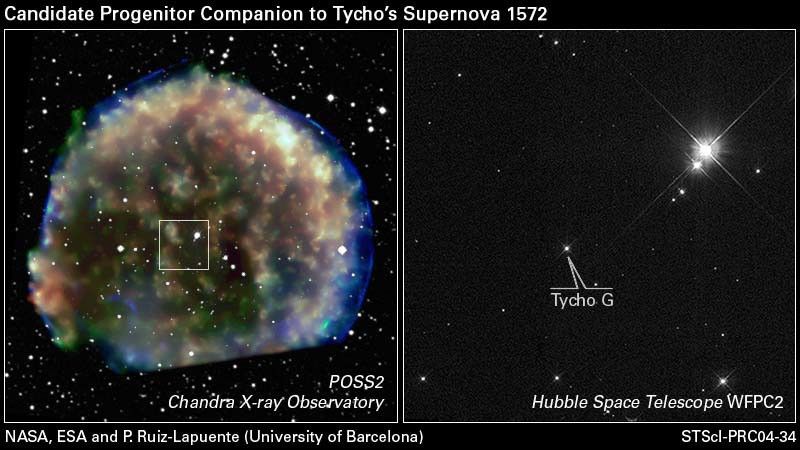1 min read
Hubble Views Suspected Stellar Survivor from 1572 A.D. Supernova Explosion

These images show the location of a suspected runaway companion star to a titanic supernova explosion witnessed in the year 1572 by the great Danish astronomer Tycho Brahe and other astronomers of that era. This discovery provides the first direct evidence supporting the long-held belief that Type Ia supernovae come from binary star systems containing a normal star and a burned-out white dwarf star. When the dwarf ultimately explodes by being overfueled by the companion star, the companion is slung away from the demised star. The Hubble Space Telescope played a key role by precisely measuring the surviving star's motion against the sky background.
[Right Image]
A Hubble Space Telescope Wide Field Planetary Camera-2 image of a small section of sky containing the candidate star. The star is like our Sun except several billion years older. It is moving through space at three times the speed of the other stars in its neighborhood. Hubble's sharp view allowed for a measurement of the star's motion, based on images taken in 1999 and 2003.
[Left Image]
The Hubble view is superimposed on this wide-field view of the region enveloped by the expanding bubble of the supernova explosion; the bubble and candidate star are at approximately the same distance, 10,000 light-years. The star is noticeably offset from the geometric center of the bubble. The colors in the Chandra X-ray image of the hot bubble show different X-ray energies, with red, green, and blue representing low, medium, and high energies, respectively. (The image is cut off at the bottom because the southernmost region of the remnant fell outside the field of view of the Chandra camera.)
The results of this research, led by Pilar Ruiz-Lapuente of the University of Barcelona, are being published in the Oct. 28 British science journal Nature. The co-authors are Fernando Comeron (European Southern Observatory), Javier Mendez (University of Barcelona and Isaac Newton Group), Ramon Canal (University of Barcelona), Stephen Smartt (Institute of Astronomy, Cambridge), Alex Filippenko (University of California, Berkeley), Robert Kurucz (Harvard-Smithsonian Center for Astrophysics), Ryan Chornock and Ryan Foley (University of California, Berkeley), Vallery Stanishev (Stockholm University), and Rodrigo Ibata (Observatory of Strasbourg).
About the Object
- R.A. PositionR.A. PositionRight ascension – analogous to longitude – is one component of an object's position.00h 25m 8.06s
- Dec. PositionDec. PositionDeclination – analogous to latitude – is one component of an object's position.64° 9' 55.69"
- ConstellationConstellationOne of 88 recognized regions of the celestial sphere in which the object appears.Cassiopeia
- DistanceDistanceThe physical distance from Earth to the astronomical object. Distances within our solar system are usually measured in Astronomical Units (AU). Distances between stars are usually measured in light-years. Interstellar distances can also be measured in parsecs.9,800 light-years (3 kiloparsecs)
About the Data
- Data DescriptionData DescriptionProposal: A description of the observations, their scientific justification, and the links to the data available in the science archive.
Science Team: The astronomers who planned the observations and analyzed the data. "PI" refers to the Principal Investigator.This image was created from HST observations from the following proposal: 9729: P. Ruiz-Lapuente (Univ. of Barcelona), A. Burrows (Univ. of Arizona), R. Canal (Univ. of Barcelona), R. Chornock Univ. of California – Berkeley), F. Comeron (European Southern Obs.), A. Filippenko (Univ. of California – Berkeley), and R. Mignani (European Southern Obs.). The science team is composed of: P. Ruiz-Lapuente (Univ. of Barcelona), F. Comeron (European Southern Observatory), J. Mendez (Univ. of Barcelona and Isaac Newton Group), R. Canal (Univ. of Barcelona), S. Smartt (Institute of Astronomy, Cambridge), A. Filippenko (Univ. of California – Berkeley), R. Kurucz (Harvard-Smithsonian Ctr. for Astrophysics), R. Chornock (Univ. of California – Berkeley), R. Foley (Univ. of California – Berkeley), V. Stanishev (Stockholm Univ.), and R. Ibata (Obs. of Strasbourg). - InstrumentInstrumentThe science instrument used to produce the data.CXO>POSS2 (left) and HST>WFPC2 (right)
- Exposure DatesExposure DatesThe date(s) that the telescope made its observations and the total exposure time.WFPC2: November 6-8 2003, Exposure Time: 1.2 hours
- FiltersFiltersThe camera filters that were used in the science observations.F555W (V)
- Object NameObject NameA name or catalog number that astronomers use to identify an astronomical object.Tycho Supernova, SN1572
- Object DescriptionObject DescriptionThe type of astronomical object.Supernova Remnant
- Release DateOctober 27, 2004
- Science ReleaseStellar Survivor from 1572 A.D. Explosion Supports Supernova Theory
- Credit

Share
Details
Claire Andreoli
NASA’s Goddard Space Flight Center
Greenbelt, Maryland
claire.andreoli@nasa.gov


































